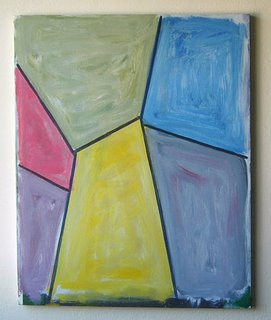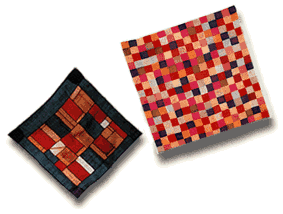 Ahhhhhh. The hint of geo, and the biological/organic feel. That was my sort of somewhat kind of aimless intention. I think. And they're painterly. They're kind of rough. They look very fast, but they were made very slowly. Those things hung on the wall, and over several weeks I'd walked past them, take a pass at them, let them hang some more. They took a long time. I did not set out to make three paintings based on the same drawing. I've never done that before. Ever. You saw it here first- history! I tend to try to make every painting be different.
Ahhhhhh. The hint of geo, and the biological/organic feel. That was my sort of somewhat kind of aimless intention. I think. And they're painterly. They're kind of rough. They look very fast, but they were made very slowly. Those things hung on the wall, and over several weeks I'd walked past them, take a pass at them, let them hang some more. They took a long time. I did not set out to make three paintings based on the same drawing. I've never done that before. Ever. You saw it here first- history! I tend to try to make every painting be different. These are all painted quite differently. All are on mid-priced commercial canvases. For some kinds of painting I like that thin fine-weave canvas with the super slick commercial gesso ground. But the two smallest are actually not on the commerical side; these were unsuccessful paintings, so I pulled the canvas off the stretcher, flipped it over and restapled, and then gessoed it myself, so it's more coarse and absorbent. If you look on the backside you see a bad painting. That had never occured to me to do before, but John Zurier had mentioned to me that he did that, especially with linen, and I've now done that several times. The largest one is on the original store-bought ground, and I think the paint quality shows that.
All of the lines are meant to read straight, none curved, but they're a bit wobbly amyway. I use a small flat brush and a raised straight edged to guide my hand, but they have a hand-painted quality, especially as the pressure of my hand varies.
I think the word is pronounced BO-ja-gee. Emphasis on the first syllable, quick on the middle syllable, draw out the last syllable. I think. It's Korean, and is sometimes spelled "pogaji".

Bojagi (Pojagi), or wrapping cloths, are Korean textiles pieced together from small scraps of cloth. Bojagi have very old origins, but those still in existence date from the Choson dynasty (1392 – 1910). They are used for wrapping, carrying and storing objects, and as table coverings, altar cloths and special-occasion decorations. Bojagi are usually square and come in a range of sizes. Fabrics used in bojagi include silk, cotton, hemp and ramie. Ramie is a fiber made from the stalks of a woody shrub indigenous and unique to Korea. It can be woven into a very thin, even-textured and strong fabric that is extraordinarily long-lasting. There are many different types of bojagi including lined or unlined, embroidered, painted and gold-leafed (URL).
My younger brother's wife's parents are from Korea. So my two nephews are Korean-American. The SF Asian Art Museum has some bogaji on display. I've been carrying the idea around in my head for three months or so.
Your Jasper Johns comparison is just fine with me. I actually like those flagstone and cross hatch paintings from the 70's. I saw those paintings when his retrospective was at SFMoMA in 1978, and I still have the catalog with the long and excellent essay by Michael Crichton (who has lately said that the scientific evidence for global warming is weak). It's interesting to see John's reusing these motifs.
I saw Johns' show of new work at Matthew Marks in May 2005. It was a big event, and I happily anticipated seeing it. But I felt that the work was really cold and hermetic; there wasn't one mark out of place, everything seemed so planned, almost like a coloring book. It was a good show, but measuring against his reputation I was disappointed.
And in that photo you posted- is it just that shirt, or has John's become incredibly barrel-chested?
No comments:
Post a Comment